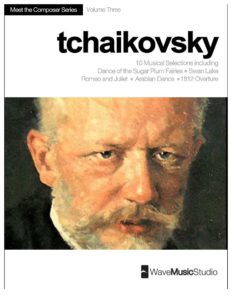Table of Contents:
Browse in the Library:
Tchaikovsky Piano Concerto No. 1, easy piano solo arr. with sheet music
The Piano Concerto no. 1 in B flat minor Op. 23 by Pyotr Ilyich Tchaikovsky, was composed between November 1874 and February 1875 at the insistence of the piano virtuoso Nikolai Rubinstein, director of the Moscow Conservatory. Tchaikovsky revised it in the summer of 1879 and later in December 1888. It is the most famous of the three piano concertos he composed.

History
Tchaikovsky thought of dedicating this work to Nikolai Rubinstein, with the wish that he would be his first performer. But when he proudly showed the concerto to the pianist and two other musician friends at Christmas 1874, Rubinstein reacted with great dismay.
After going over it together at the piano, Rubinstein irritably dismissed the concerto as ‘banal, clumsy and incompetently written’ as well as ‘ill-composed and impossible to perform.’ He then asked Tchaikovsky to undertake the task of revising it to suit his wishes.
But Tchaikovsky refused to follow these instructions, and changed the dedication, this time making the recipient of the work the famous German pianist and conductor Hans von Bülow, an admirer of Tchaikovsky’s music who described the work as ‘ very original and noble’. Ironically, von Bülow later removed the concerto from his repertoire, while Rubinstein later conducted the Moscow premiere and performed the solo part on several occasions.
The premiere took place in Boston on October 25, 1875, under the direction of Benjamin Johnson Lang and with the solo part by Von Bülow. The Russian premiere took place a week later in St. Petersburg, with Russian pianist Gustav Kross and Czech conductor Eduard Nápravník. The soloist at the premiere in Moscow in 1875 was Sergey Taneyev.
Instrumentation
The work is orchestrated for 2 flutes, 2 oboes, 2 clarinets in B flat, 2 bassoons, 4 trumpets in F, 2 trumpets in F, 3 trombones (tenor, tenor, bass), timpani, solo piano, and instruments of string.
Structure
The concert follows the traditional form of three movements:
Allegro non troppo e molto maestoso – Allegro con spirito
Andantino simplice – Prestissimo
Allegro con fuoco
The concert is famous for the dramatic tension between soloist and orchestra. It is markedly symphonic in character, and differs greatly from the more musical and apparently virtuosic type of concert that was common in Russia at the time. This does not mean that the technical demands of the solo part are not considerable.
For example, there are a few passages with rapid movement of octaves. The speed and intrinsic difficulty of the writing put more obstacles in the interpretation. In addition, the soloist has to face the monumental nature of the work with a poignant tone that often has to dominate over the orchestra.
The popular theme of the introductory section of the first movement is based on a melody that Tchaikovsky heard from blind street musicians at a market in Kamenka, near Kyiv (Ukraine).
This fragment, the best known of the entire concerto, is remarkable for its almost independent character from the rest of the movement. It is not composed in the nominal key of the work, B flat minor, but in the complementary major key of D flat major.
Despite its notorious nature, the theme is heard only twice, and does not appear again throughout the concert. Tchaikovsky, a composer with an extraordinary melodic invention, here allows himself the luxury of using this exuberant melody in an almost circumstantial way, without further development or re-exposure.
Curiosities
The concert was arranged for two pianos by Tchaikovsky himself in December 1874; revised December 1888.
It was revised three times by the composer, the last time in 1881, which is the version performed today.
Van Cliburn won the 1st International Tchaikovsky Competition in 1958 with this work. The music world was perplexed, as it was an American competing in Moscow in the middle of the Cold War.
Vladimir Horowitz performed this concerto as part of a World War II fundraising concert in 1943, under the direction of his father-in-law, Arturo Toscanini and with the NBC Symphony Orchestra. There are two versions recorded by Horowitz and Toscanini, the 1943 live version and a 1941 studio version.
In the United States of America, it became very popular when it was used in the radio program ‘Mercury Theatre’, directed by Orson Welles. The play was associated with Welles throughout the director and actor’s career and was often played when it was presented on radio or television.
The opening chords are quoted in the song Hoodoo by the rock group Muse (from their album ‘Black Holes and Revelations’). The quotation is performed in the complementary minor key (B flat minor) of the original (D flat major).
It sounded at the entrance of the Olympic torch-bearer into the stadium at the 1980 Summer Olympics in Moscow
It was used in the animated film ‘The Meaning of Life’, by Don Hertzfeldt.
